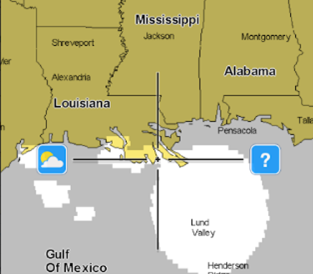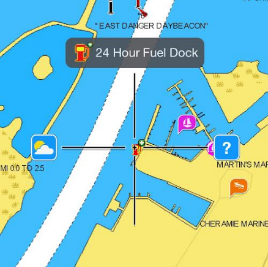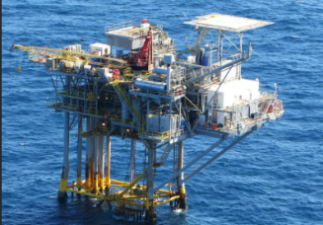June 6-12, 2024. 1000 NM across the Gulf of Mexico. | Hylas Service Centre, Fort Lauderdale, FL to Galveston, TX.
By Kevin Wensley
A tale of design appreciation, performance, frustration, joy, waterspouts, starry nights and dodging abandoned oil platforms.
Making a Gulf crossing happens one of three ways. The very long way with multiple stops in Florida and Louisiana, the long way going north to avoid the Florida Loop*, and or the “Sling Shot” to the south toward the Yucatan then riding the loop north toward Louisiana.
*Florida Loop
The loop current is a warm ocean current that flows northward between Cuba and the Yucatán Peninsula. It then moves north into the Gulf of Mexico, loops east and south, and finally exits to the east through the Florida Straits, joining the Gulf Stream. This fascinating current changes its extension over time, sometimes forming a large loop that nearly reaches the Mississippi Delta before exiting the Gulf.
Tracking the loop is easy enough through a number of “pay to play” apps. We had access to Windy Premium.
A popular time to cross is late May after the stronger fronts are in decline. There is often a few days weather window with favorable winds. Once June arrives however, we start to keep a watchful eye on the tropics. The later in the summer, the bigger the risk of tropical activity, the more variable the winds, and the more frequent the pop-up squalls.

Here’s one we were avoiding off Louisiana with a waterspout preceding the squall. A “fair weather” waterspout rarely produces winds above 40knts and covers a very small area, still well worth avoiding. The bigger concern with squalls for any size yacht is lightning. Something “out of the blue” refers to a lightning strike that can happen in clear sky up to 13 miles from a storm.
Go time
Our go time decision was based on a few factors:
We had missed a window in May as the Hylas team were keen to give subcontractors time to complete optional items for the new owner. As is so often the case, life pressures to fulfill obligations was forcing our hand. Early June became the “drop dead” for a departure. We had a window of quiet in the tropics, although the long-term forecast did show significant rain over the eastern Gulf a few days out. In the words of the owner, it looked very wet but not very whirly. In hindsight the forecast was accurate with record breaking rainfall in the eastern Gulf and Florida as we were making our final approaches to Texas.
The weather challenge this trip was going to be the lack of wind! A forecast that predicts a significant event is far more accurate than one that is trying to bring meaningful data beyond light and variable. A 6-day window of 0-10 kts being predicted from just about every point of the compass was what we were dealing with.
What We Learned
Motor-sail versus just motoring when necessary – There really is a fuel consumption saving with as little as 5 knots of true wind anywhere abaft the beam.
We left Lauderdale after sunset on Thursday to avoid a Friday departure. I am a little superstitious. This would put us in Key West late Friday night, after the fuel docks had closed! Not wanting to lose 8 hrs waiting till morning we pulled into Marathon late in the afternoon of Friday. We topped up the two 143 gallon tanks (286 gals total). We had about 850 nautical miles to go and we factored 20 gallons as a reserve. The weather forecast at that time was for 0-5 for the next few days, with little hope of sea or land breezes as we moved further offshore.
For those that enjoy the math
850 miles
266 gallons
A goal of arriving on Wednesday early PM -120hrs
Here’s data we had. We were not able to factor in current
Burning 2gph achieving 6.5kts at 1760 RPM
Burning 3gph achieving 7.5kts at 2100 RPM
Burning 3gph achieving 8.2kts at 2350 RPM
With 5kts of true wind abaft the beam motor sailing the numbers were 1.8gph achieving 7.2kts at 1760 RPM
It was these calculations that pushed us in to Louisiana for a top up. In hindsight this wasn’t necessary, but it took a lot of anxiety out of the last couple of days
Starlink— I am a great believer in the wisdom of Eisenhower when he is reputed to have said. “Planning is everything, the plan itself is nothing”. Flexibility is the key and Elon’s Starlink worked great. The RV system is what I had with the antenna mounted to the flagpole holder on the davits and “Mobile Priority” activated. This turned out to be worth the activation fee and $2/GB. Finding Grand Isle, Louisiana would have been impossible. Calling in for opening details and any local knowledge couldn’t have happened without it. Timing our arrival perfectly to match the 5am opening of the 24hr fuel dock! I can’t say enough about the friendly reception and facilities that were open at that time of the day. Keep this one up your sleeve if you need bolt hole. Thanks to Elon daily weather and loop forecasts were also made very easy.
Avoid the Florida loop—so go “the long way”, i.e. the northerly route and try to find counter eddies.
Tracking the loop is readily done using apps like Windy
There are some eddies you can find that help you along
Don’t hit any derelict or active oil platforms – There are plenty out there that are not charted and plenty charted and not out there!
Radar is essential. There are some areas where the obstructions are not obvious.
Overlaying radar on a chart plotter shows the rigs that are easily observed, there are many charted that are no longer there – but what lies beneath?
There’s plenty of additional oil business related traffic as well so AIS is also a must.
Stay as rested as possible – 3 crew on 3 hour watches worked well. This also meant your night watch was varied. Be strict with yourself and crew about getting rest and keeping to a schedule.

Avoid lightning whenever possible – This could mean motoring to get the best advantage even if there is good wind. The downside of a strike goes way beyond the strike itself. Even when the insurance company writes a check, you’ll have weeks, if not months, of dealing with subcontractors and years of gremlins that you will quietly suspect came aboard the same day.
Using radar to track squalls and the EBL (Electronic Bearing Line) feature to predict their movement will give you your best chance of avoiding them.

Fishing was important but not particularly successful.
Learning how to fillet a fish and establishing a filleting station will make the catching experience more enjoyable and contain any mess.
Beautifull clear starry nights – Possibly the highlight of the trip.
The night sky observed without light pollution is one of the most awe-inspiring things you’ll see on a passage a few miles offshore. If you want to make night watches more enjoyable learn a little about the planet’s stars and constellations. Here’s a book the folks at SAIL recommend. Stikky Night Skies
All in all, a successful passage with lots of good learning. The Hylas H57 is a superb yacht in many respects. Ease of handling with all the power systems. Deploying sails when you think the wind angle might be just enough is so easy. Reefing the jib and furling the main takes seconds when a squall hits.
The hard top enclosure makes being on deck in any conditions so much more pleasant, in this instance it was mostly the shade we enjoyed. This of course also meant the standard solar package mounted on top was doing its best work.
The cockpit is huge with plenty of lounging or snoozing space.
The fuel capacity and ranges that can be attained make long passages much easier to plan.
The solar panels assist the lithium batteries. The ability to run the air-con underway on hot nights keeps you comfortable and well rested. Generator running is reduced to a couple of hours in the morning if necessary.
The helm stations can be fully enclosed without compromising the 360-degree visibility.
Easy access to all the navigational and engine systems are duplicated on both sides.
Last but not least—
I’m sure the rest of the crew won’t mind me saying that we had two constant companions that were, I genuinely believe, curious about each other. Bikini the seafaring Boston Terrier and the ever-present bow riding Dolphins. Both were a joy to have around.
Always an adventure.
























Comments